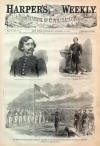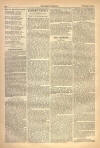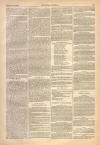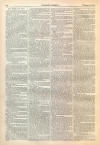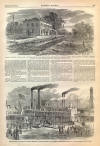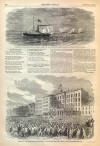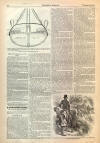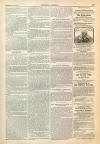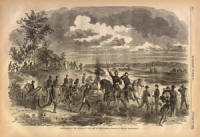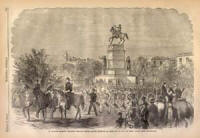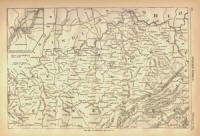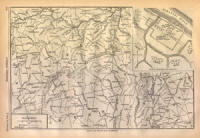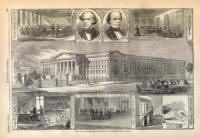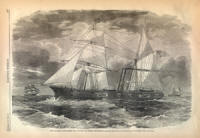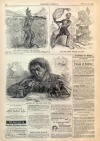Iron Clad Gun Boat
|
|
This Site:
|
HARPER'S WEEKLY. [OCTOBER 19, 1861. 670 A, Keelson.—B, Keel.—C, Outer planking.—D, Ribs.—E, Inside planking.—F, Knees.—G, Gun deck.—H, Main rail (wood).—I, Iron plating.—J, Boat davits,—K, Hand rail.—L, Upper deck, bomb-proof.—M, Water-line.-N, Port-holes. —O. Mast.—P. Rigging. MIDSHIP SECTION OF THE IRON-CLAD SHIP. THE NEW IRON-CLAD GUNBOAT.WE publish on page 669 a picture of THE NEW IRON-CLAD GUN-BOAT, which is now being constructed at Mystic, Connecticut, by C. H. Bushnell, of New Haven. The following accurate description is from the Herald: This vessel, the first one built in this country, will be about one thousand tons register. Her dimensions are as follows: Length over all, two hundred feet; extreme breadth, thirty-six feet six inches; depth of hold, twelve feet eight inches ; draught of water, about eleven feet. The keel is of white oak, sided fourteen inches, in depth fourteen inches. Garboard strokes are six inches in thickness ; bottom plank four inches thick; wales four and a half inches in thickness. The bottom plank are fastened with three locust tree-nails and one composition spike in each strake. The engine and boiler keelsons will be of white oak and yellow pine, and of such dimensions as will be deemed proper by the engineer department. The frame of the vessel will be entirely solid. Ordinarily large spaces are left between the ribs and timbers of vessels, but here they will be made solid with "fillings." Some idea can be formed of the thickness of the vessel when we say that it is twenty inches from the outside to the inside before the iron plating is put upon her. The beams are of yellow pine, twelve by nine and a half inches, and the deck plank will be of the same material, four inches in thickness. The cabins, ward-room, and steerages will be fitted up similar to those in the new gun-boats just launched. She has one flush deck, which is the fighting deck. Forward and aft will be half decks for officers, etc., but the engines and boilers will of course occupy the midship portion of it. The fighting deck, as well as the two half decks, are of wood, but the upper deck is only the upper part of the bomb-proof which covers the gunners. There will be no houses or guns on this deck, and it will be only used for a promenade and to work the ship while under canvas. The companion-ways will give access to the deck from below. A series of iron stanchions are placed around this deck, on which are placed a wire netting to prevent persons from falling overboard. She will be brig rigged forward and schooner rigged aft, no that she will in rig be a hermaphrodite brig. These spars will be light, as she will depend principally on her steaming powers. She will have a small bowsprit., made of iron, but it will not project outside of the vessel more than four feet. She will carry four boats at her davits, which hoist sufficiently high to be out of the way of the guns. All the standing rigging will be of wire rope, which is less liable to be cut by fragments of shell. The steersman will be located below decks, and a lookout forward will signal to him while at the after wheel, and when he is at the forward wheel he can see for himself. [Entered according to Act of Congress, in the Year 1861, by Harper & Brothers, in the Clerk's Office of the District Court for the Southern District of New York.] A STRANGE STORY.Printed from the Manuscript and early Proof–sheets purchased by the Proprietors of "Harper's Weekly." CHAPTER XXVIII. THE conversation with Mrs. Poyntz left my mind restless and disquieted. I had no doubt, indeed, of Lilian's truth ; but could I be sure that the attentions of a young man with advantages of fortune so brilliant would not force on her thoughts the contrast of the humbler lot and the duller walk of life in which she had accepted as companion a man removed from her romantic youth less by disparity of years than by gravity of pursuits? And would my suit now be as welcomed as it had been by a mother even so unworldly as Mrs. Ashleigh ? It perplexed me, too, that neither mother nor daughter should have given me no cause in their letters to suspect that I had a rival in this favorite of fortune. Lilian's letters, it is true, touched but little on any of the persons round her—they were filled with the outpourings of an ingenuous heart, colored by the glow of a golden fancy. They were written as if in the wide world we two stood apart, alone, consecrated from the crowd by the love that, in linking us together, hallowed each to each. But Mrs. Ashleigh's letters had been more general and diffusive, detailed the habits of the household, sketched the guests, intimated continued fear of Lady Haughton, but had said nothing more of Mr. Ashleigh Sumner than I had repeated to Mrs. Poyntz. However, in my letter to Lilian I related the intelligence that had reached me, and impatiently I awaited her reply. Three days after the interview with Mrs. Poyntz, and two days before the long-anticipated event of the mayor's ball, I was summoned to attend a nobleman who had lately been added to my list of patients, and whose residence was about twelve miles from L-. The nearest way was through Sir Philip Derval's park. I went on horseback, and proposed to stop on the way to inquire after the steward, whom I had seen but once since his fit, and that was two days after it, when he called himself at my house to thank me for my attendance, and to declare that he was quite recovered; fearful, no doubt, that I might otherwise want to make a long bill out of him. As I rode somewhat fast through Sir P. Derval's park, I came, however, upon the steward, just in front of the house. I reined in my horse and accosted him. He looked very cheerful. "Sir," said he, in a whisper, "I have heard from Sir Philip ; his letter is dated since—since —my good woman told you what I saw ; well, since then. So that it must have been all a delusion of mine, as you told her. And yet, well —well—we will not talk of it, doctor. But I hope you have kept the secret. Sir Philip would not like to hear of it if he comes back." "Your secret is quite safe with me. But is Sir Philip likely to come back?" "I hope so, doctor. His letter is dated Paris, and that's nearer home than he has been for many years ; and—but bless me — some one coming out of the house ? a young gentleman ! Who can it be ?" I looked, and to my surprise I saw Margrave descending the stately stairs that led from the front door. The steward turned toward him, and I mechanically followed, for I was curious to know what brought Margrave to the house of the long-absent traveler. It was easily explained. Mr. Margrave had heard at L- much of the pictures and internal decorations of the mansion. He had by dint of coaxing (he said, with his enchanting laugh) persuaded the old housekeeper to show him the rooms. "It is against Sir Philip's positive orders to show the house to any stranger, Sir ; and the housekeeper has done very wrong," said the steward. "Pray don't scold her. I dare say Sir Philip would not have refused me a permission he might not give to every idle sight-seer. Fellow-travelers have a freemasonry with each other ; and I have been much in the same far countries as himself. I heard of him there, and could tell you more about him, I dare say, than you know yourself." " You, Sir ! pray do then." "The next time I come," said Margrave, gayly ; and with a nod to me he glided off through the trees of the neighboring grove, along the winding foot-path that led to the lodge. "A very cool gentleman," muttered the steward ; " but what a pleasant way with him! You seem to know him, doctor. Who is he—may I ask ?"
" Mr. Margrave. A visitor at L-,
and he
" I must go and hear what he said to Mrs. Gates ; excuse me, Sir, but I am so anxious about Sir Philip." "If it be not too great a favor, may I be allowed the same privilege granted to Mr. Margrave ? To judge by the outside of the house, the inside must be worth seeing ; still, if it be against Sir Philip's positive orders—" "His orders were not to let the Court become a show-house—to admit none without my consent; and I should be ungrateful indeed, doctor, if I refused that consent to you." I tied my horse to the rusty gate of the terrace-walk, and followed the steward up the broad stairs of the terrace. The great doors were unlocked. We entered a lofty hall with a domed ceiling; at the back the grand staircase ascended by a double flight. The design was undoubtedly Vanbrugh's, an architect who, beyond all others, sought the effect of grandeur less in space than in proportion. But Vanbrugh's designs need the relief of costume and movement, and the forms of a more pompous generation, in the bravery of velvets and laces, glancing amidst those gilded columns, or descending with stately tread those broad palatial stairs. His halls and chambers are so made for festival that they become ineffably desolate and gloomy amidst solitude and decay. The housekeeper had now appeared—a quiet, timid old woman. She excused herself for admitting Margrave, not very intelligibly. It was plain to see that she had, in truth, been unable to resist what the steward had called his " pleasant ways." As if to escape from a scolding, she talked volubly all the time, bustling nervously through the rooms, along which I followed her guidance with a hushed footstep. The principal apartments were on the ground-floor, or rather a floor raised some ten or fifteen feet above the ground; they had not been modernized since the date in which they were built. Hangings of faded silk ; tables of rare marble, and mouldered gilding; comfortless chairs at drill against the walls ; pictures, of which connoisseurs alone could estimate the value, darkened by dust or blistered by sun and damp, made a general character of discomfort. On not one room, on not one nook, still lingered some old smile of Home. Meanwhile, I gathered from the old woman's rambling answers to questions put to her by the steward, as I moved on, glancing at the pictures, that Margrave's visit that day was not his first. He had been over the house twice before ; his ostensible excuse that he was an amateur in pictures (though I knew, as I have before observed, that for that department of art he had no taste) ; but each time he had talked much of Sir Philip. He said that, though not personally known to him, he had resided in the same towns abroad, and had friends intimate with Sir Philip; but when the steward inquired if the visitor had given any information as to the absentee, it became very clear that Margrave had been rather asking questions than volunteering intelligence. We had now got to the end of the state apartments, the last of which was a library. "And," said the old woman, " I don't wonder the gentleman knew Sir Philip, for he seemed a scholar, and looked very hard over the books, especially those old ones by the fire-place, which Sir Philip, Heaven bless him ! was always poring into." Mechanically I turned to the shelves by the fire-place, and examined the volumes ranged in that department. I found they contained the works of those writers whom we may class together under the title of mystics—Porhyry and Plotinus; Swedenborg and Behmen; Sandivogius, Van Helmont, and Cardan. Works, too, were there, by writers less renowned, on astrology, geomancy, chiromancy, etc. I began to understand among what class of authors Margrave had picked up the strange notions with which he was apt to interpolate the doctrines of practical philosophy. "I suppose this library was Sir Philip's usual sitting-room ?" said I. "No, Sir ; he seldom sat here. This was his study ;" and the old woman opened a small door, masked by false book backs. I followed her into a room of moderate size, and evidently of much earlier date than the rest of the house. "It is the only room of the old mansion," said the steward, in answer to my remarks. "I have heard it was left standing on account of the chimney-piece. But there is a Latin inscription which will tell you all about it. I don't know Latin myself," said the steward. The chimney-piece reached to the ceiling. The frieze of the lower part rested on rude stone caryatides; in the upper part were oak panels very curiously carved in the geometrical designs favored by the taste prevalent in the reigns of Elizabeth and James, but different from any I had ever seen in drawings of old houses. And I was not quite unlearned in such matters, for, as I have before said, my poor father was a passionate antiquarian in all that relates to medieval art. The design in the oak panels was composed of triangles interlaced with varied ingenuity, and inclosed in circular bands inscribed with the signs of the Zodiac. On the stone frieze supported by the caryatides, immediately under the wood-work, was inserted a metal plate, on which was written, in Latin, a few lines to the effect that "in this room, Simon Forman, the seeker of hidden truth, taking refuge from unjust persecution, made those discoveries in nature which he committed, for the benefit of a wiser age, to the charge of his protector and patron, the worshipful Sir Miles Derval, knight." Forman ! The name was not quite unfamiliar to me; but it was not without an effort that my memory enabled me to assign it to one of the most notorious of those astrologers or soothsayers whom the superstition of an earlier age alternately persecuted and honored. The rest of the room was more cheerful than the statelier chamber I had passed, for it had still the look of habitation. The arm-chair by the fire-place ; the knee-hole writing-table beside it ; the sofa near the recess of a large bay-window, with book-prop and candlestick screwed to its back; maps, coiled in their cylinders, ranged under the cornice ; low strong safes, or cupboards, probably for papers and title-deeds, skirting two sides of the room, with articles familiar to modern use on their ample shelves ; a fowling-piece here ; fishing-rods there; two or three simple flower vases; a pile of music-books; a box of crayons—all seemed to speak of residence and ownership—had the idiosyncrasies of a lone single man, it is true, but of a man of one's own time—a country squire of plain habits but not uncultivated tastes. I moved to the window ; it opened by a sash upon a large balcony, within which a wooden stair wound to a little garden, not visible in front of the house, surrounded by a thick grove of evergreens, through which one broad vista was cut ; and that vista was closed by a view of the mausoleum. I stepped out into the garden—a patch of sward with a fountain in the centre—and parterres, now more filled with weeds than flowers. At the left corner, a tall wooden summer-house or pavilion; its door open. "Oh, that's where Sir Philip used to study many a long summer's night," said the steward. "What! in that damp summer-house?" "It was a pretty place enough then, Sir ; but it is very old. They say as old as the room you have just left." " Indeed, I must look at it, then." The walls of this summer-house had once been painted in the arabesques of the Rennaissance period; but the figures now were scarcely traceable. The wood-work had started in some places, and the sunbeams stole through the chinks and played on the floor, which was formed from old tiles quaintly (Next Page)
"I LOOKED, AND TO MY SURPRISE I SAW MARGRAVE
DESCENDING THE STATELY STAIRS THAT
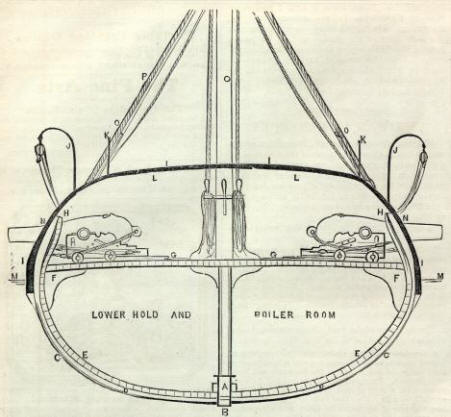 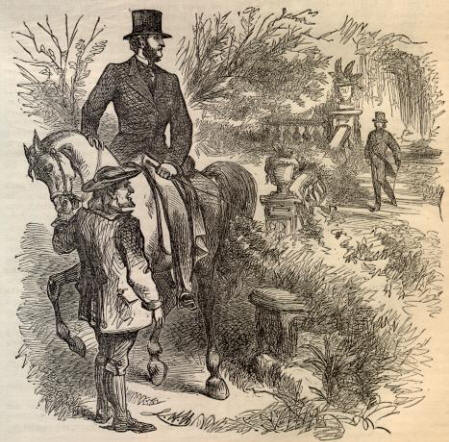 |
||||||||||||||||||||||||||||||||
|
|
||
|
|
Site Copyright 2003-2018 Son of the South. For Questions or comments about this collection, contact: paul@sonofthesouth.net |
|
|
Are you Scared and Confused? Read My Snake Story, a story of hope and encouragement, to help you face your fears. |
||
